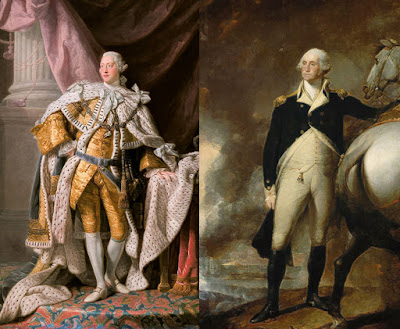(King George III and George Washington
in their pomp)
On top of this they were both famous for being "farmers". Washington was famous for his advocacy of farming innovations, and King George acquired the nickname "Farmer George" due to his similar enthusiasm. An article on the Library of Congress website titled Washington and the New Agriculture contains the following passage which highlights this cross-Atlantic parallel;
The surviving diaries [of Washington] which deal with agriculture begin in 1760, a year sometimes used to denote the beginning of a new agriculture in England. It was also the year of the ascension of George III, a monarch so fond of farming that he maintained experimental plots at Windsor and submitted articles for publication under the name of his farm overseer. The influence of English agriculture on Washington and others in this country--Jefferson included--was indeed great.In fact, a famous quote attributed to George Washington is the following;
"I had rather be on my farm than be emperor of the world"A sentiment that could perhaps be said to be common to both Georges.
(King George III and his wife Queen Charlotte
depicted as a farmer and his wife)
Another interesting thing worth noting is that the name George is actually said to mean "farmer" or "earth worker". Coming from the Greek Georgios (Γεωργιος), hence the root geo in words like geography.
So far, so similar. However, an even more curious similarity comes in the odd fact that both Georges were associated with famous Whites Houses. The "white house" associated with George Washington is of course the universally known the White House - set in the American capital so named for him. Though it should be noted that Washington never actually resided at that White House during his lifetime. John Adams was the first US president to occupy the building, as it was still under construction during Washington's time in office. Washington did however spend time at another white house - in this case the White House plantation where he was said to have courted Martha Washington. Some have speculated that this is where the main White House derived its name. So I guess you could say he was doubly associated with a "white house".
(Earliest known photograph of the White House,
Washington. Circa 1846.)
What's generally less well known however is that George III was also associated with a white house. His being the White House at Kew on the Thames, up river from London. It was at this White House that George was kept during his supposed bouts of "madness". Interestingly, this White House at Kew was demolished in 1802, just two years after the White House in Washington was completed.
(Illustration of the White House
at Kew, England. 1734.)




hi
ReplyDeletewhat the sigma
ReplyDelete